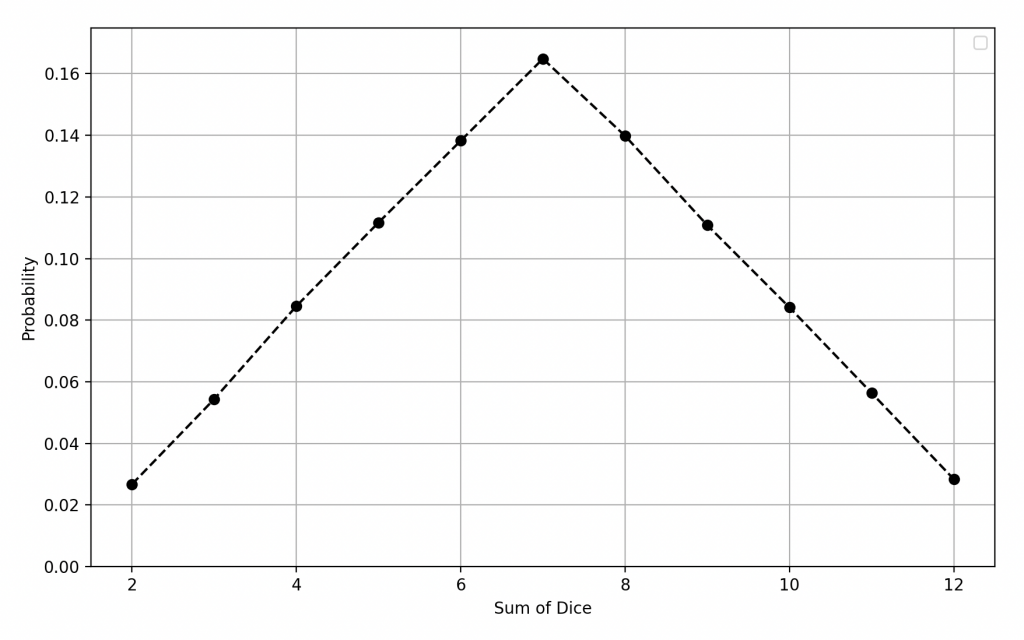As the adventurers strive to silently navigate the dark labyrinth of the dungeon, most of them manage to maintain relative discretion. However, a few members of the group, overcome by the urgency of the situation, fail to completely contain the noise of their steps and agitated breaths.
Fate takes an unrelenting turn, and one of the adventurers makes an unfortunate misstep, causing a significant noise. This sudden sound alerts the guards patrolling nearby, plunging the adventurers into a critical situation as a garrison of guards rapidly approaches.
Now facing imminent capture, they see the guards swiftly surround them, subdue them, and bind them. Their escape attempt is a bitter failure, and they are led back to their original cell in the dungeon.
Meanwhile, the magician, undeterred, continues her exposition on the triangular probability distribution. The adventurers, compelled to return to their grim captivity, know that their situation is becoming increasingly desperate, while fate seems to be playing against them.
The Law of Two Dice
Magician: My dear friends, now that you have a solid understanding of the discrete uniform distribution, let me tell you about another intriguing distribution, the triangular distribution, which occurs when we roll two six-sided dice and sum the values obtained on their top faces.
Unlike the uniform distribution we discussed earlier, the triangular distribution has a different distribution of probabilities.
For a single roll of a fair and unbiased six-sided die, the probability of obtaining any value from 1 to 6 is uniformly distributed, which means a 1/6 probability for each outcome. This is a discrete uniform distribution. However, when we roll two dice and add the values, the outcomes are no longer uniformly distributed but instead follow a triangular distribution.

Sum of dice is 2: Probability 1/36
Sum of dice is 3: Probability 2/36
Sum of dice is 4: Probability 3/36
Sum of dice is 5: Probability 4/36
Sum of dice is 6: Probability 5/36
Sum of dice is 7: Probability 6/36
Sum of dice is 8: Probability 5/36
Sum of dice is 9: Probability 4/36
Sum of dice is 10: Probability 3/36
Sum of dice is 11: Probability 2/36
Sum of dice is 12: Probability 1/36

As you can see, the most likely sum is 7, with a probability of 6/36, while the extremes, 2 and 12, have the lowest probability, with only 1/36.
There are several possible combinations with two six-sided dice to obtain a certain sum. Let me list them:
To get a sum of 2, there is only one possible combination: 1+1.
To get a sum of 3, there are two possible combinations: 1+2 and 2+1.
To get a sum of 4, there are three possible combinations: 1+3, 2+2, and 3+1.
And so on, until we reach a sum of 12, which has only one possible combination: 6+6.
This triangular distribution is fascinating because it reflects how probabilities are distributed when combining the results of two dice. Keep in mind that this knowledge might come in handy in your future adventures, as it will allow you to estimate the chances of success when dealing with situations that require complex dice rolls.
It's not Over !
However, it’s important to remember that everything just narrated isn’t the true ending of the story but rather a variation of what could have happened.
In the world of role-playing games, possibilities are endless, and the fate of our adventurers often relies on the players’ choices and the Game Master’s decisions. So, let the quest go on because every adventure is unique and unpredictable, and new challenges await our brave heroes in the dark corners.
Find the true ending.
Bibliography
M. Fréchet, M. Halbwachs, Le calcul des probabilités à la portée de tous, Dunod, 1924, 297 p.
C. Barboianu, Probability Guide to Gambling. The Mathematics of Dice, Slots, Roulette, Baccarat, Blackjack, Poker, Lottery and Sport Bets, INFAROM Publishing, 2006, 316 p
P. Nahin, Digital Dice. Computational Solutions to Practical Probability Problems, Princeton University Press, 2008, 263 p.
I. Stewart, Do Dice Play God?: The Mathematics of Uncertainty, 2019
import matplotlib.pyplot as plt
import numpy as np
# Number of simulations
n_simulations = 100000
# Simulations of rolling two dice and calculating sums
results = np.random.randint(1, 7, size=(n_simulations, 2))
sums = np.sum(results, axis=1)
# Calculation of probability density
unique, counts = np.unique(sums, return_counts=True)
probability = counts / n_simulations
# Creating the probability density plot
plt.figure(figsize=(10, 6))
plt.plot(unique, probability, marker='o', linestyle='--', color='black')
# Labeling axes and adding a title
plt.xlabel('Sum of Dice')
plt.ylabel('Probability')
# Limiting the y-axis scale from 0 to the maximum probability
plt.ylim(0, max(probability) + 0.01)
# Displaying the legend
plt.legend()
# Displaying the plot
plt.grid(True)
plt.show()
